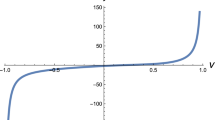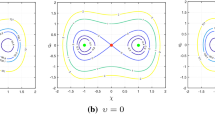Abstract
Linear second-order systems with numerator-dynamics are considered and their transient responses are investigated for discontinuous inputs. Characteristic parameters for second-order systems with numerator dynamics are identified. The solution profiles of these systems depend upon the value of one such parameter relative to that of the others on the number line. Effects of initial jump discontinuities of the inputs on the correctness of the solutions are also treated. A methodology for analysis of discontinuities is presented. Initial discontinuities of the calculated response either get accounted for in the input function or the initial condition of the input function for all but the following case. For the impulse response alone, that too among inherent numerator-dynamics systems only, an initial di scontinuity cannot be accounted for in the input. The value of that discontinuity is thus required for correct solutions of these cases. The results are general and extendable to different inputs and higher order systems.
Similar content being viewed by others
References
Coughanowr, D.R., Process Systems Analysis and Control, New York: McGraw-Hill, 1991.
Harriott, P., Process Control, India: Tata McGraw-Hill Ed., 1972.
Luyben, W.L., Process Modeling, Simulation and Control for Chemical Engineers, New York: McGraw-Hill, 1990.
Bequette, B.W., Process Dynamics: Modeling, Design and Simulation, Upper Saddle River: Prentice Hall PTR, 1998.
Bequette, B.W., Process Dynamics: Modeling, Design and Simulation, New Jersey: Prentice Hall PTR, Upper Saddle River, 2002.
Hwang, C. and Hwang, J.H., A New Step Iterative Method for Optimal Reduction of Linear SISO Systems, J. Franklin Inst., 1996, vol. 133, no. 5, pp. 631–645.
Padma, S.R. and Chidambaram, M., Simple Method of Calculating Set Point Weighting Parameter for Unstable Systems with a Zero, Comp. Chem. Eng., 2004, vol. 28, no. 11, pp. 2433–2437.
Strogatz, S.H., Love-Affairs and Differential Equations, Math. Magazine, 1988, vol. 61, p. 35.
You, K.H. and Lee, E.B., Time Maximum Disturbance Switch Curve Isochrones of Linear Second-Order with Numenator-Dynamics, J. Franklin Inst., 2000, vol. 337, no. 6, p. 725–742.
You, K.H. and Lee, E.B., BIBO Stability Integral for Second-Order Systems with Numenator-Dynamics, Automatica, 2000, vol. 36, no. 11, pp. 1693–1699.
Calabree, G., Finite Differencing Second-Order Systems Describing Black-Hole Space Times, Phys. Rev. D: Particles, Fields, Gravitation, and Cosmology, 2005, vol. 71, no. 2, pp. 1–4.
Garay, M.A.B., Melendzand, J.U., and Berriel, M.C.H., Didactic Prototype of Feed-Back Automatic Control, Advances en Ingenieria Qumica, 1998, vol. 7, no. 2, pp. 139–142.
Hall, I.A.M., Human Pilot as a Servo Problem, J. R. Aeronautical Soc., 1963, vol. 67, p. 351.
Hoffer, M.S. and Resnick, W., A Study of Agitated Liquid/Liquid Dispersions: Dynamic Response of Dispersion Geometry to Changes in Composition and Temperature, Trans. Inst. Chem. Eng., 1979, vol. 57, no. 1, pp. 1–7.
Panda, R.C., Estimation of Parameters of Under-Damped Second-Order Plus Dead-Time Systems Using Relay Feedback, Comp. Chem. Eng., 2006, vol. 30, no. 5, pp. 425–434.
Stephanopoulos, G., Chemical Process Control: An Introduction to Theory and Practice, Englewood Cliffs: Prentice-Hall, 1984.
Makila, P.M., A Note on the Laplace Transform Method for Initial Value Problems, Int. J. Control, 2006, vol. 79, pp. 36–41.
Bulgakova, N.M. and Burakov, I.M., Non-Linear Hydrodynamic Waves: Effect of Equation of State, Phys. Rev. E: Statistical, Non-Linear, and Soft Matter Phys., 2004, vol. 70, no. 3–2, pp. 036303-1–036303-5.
Hirshberg, J., Alksne, A., Colburn, D.S., Bame, S.J., and Hundhausen, A.J., Observation of Solar Flare Induced Interplanetary Shock and Helium-Enriched Drive Gas, J. Geophys. Res., 1970, vol. 75, no. 1, pp. 1–15.
Karelsky, K.V, Papkov, V.V, and Petrosyan, AS., The Initial Discontinuity Decay Problem for Shallow Water Equations on Slopes, Phys. Lett. A, 2000, vol. 271, nos. 5, 6, pp. 349–357.
Pederson, H. and Tanoff, M., Solving Parabolic PDE’s with Initial Discontinuities: Application to Mixing with Chemical Reactions, Comp. Chem. Eng., 1982, vol. 6, no. 3, pp. 197–207.
Pons, P. and Blasquez, G., Transient Response of Capacitative Pressure Sensors and Actuators, A: Physical, 1992, vol. A32, nos. 1–3, pp. 616–621.
Poon, T.W., Yip, S., Ho, P.S., and Abraham, F.F., Ledge Interactions and Stress Relaxations on Silicon (001) Stepped Surfaces, Phys. Rev. B: Condens. Matter Mat. Phys., 1992, vol. 45, no. 7, pp. 3521–3531.
Shao, Z., Kong, D., and Li, Y., Global Solutions with Shock Waves to the Generalized Riemann Problem for a Class of Quasilinear Hyperbolic Systems of Balance Laws, Nonlinear Analysis, 2006, vol. 64, no. 11, pp. 2575–2603.
Levenspiel, O., Chemical Reaction Engineering, New York: John Wiley and Sons, 1999.
Al-Hayani, W. and Casaiiss, L., On the Applicability of the Adomian Method to Initial Value Problems with Discontinuities, Appl. Math. Lett., 2006, vol. 19, no. 1, pp. 22–31.
Benchhra, M., Ntonyas, S.K., and Vahab, A.O., Extremal Solutions of Second-Order Impulsive Dynamic Equations on Time Scales, J. Math. Anal. Appl., 2006, vol. 324, no. 1, pp. 425–434.
Casasus, L. and Al-Hayani, W., The Decomposition Method for Ordinary Differential Equations with Discontinuities, Appl. Math. Comput., 2002, vol. 131, nos. 2–3, pp. 245–251.
Karelsky, K.V. and Petrosyan, A.S., Particular Solutions and Riemann Problem for Modified Shallow Water Equations, Fluid Dynamic Res., 2006, vol. 38, no. 5, pp. 339–358.
Kelevedjiev, P. and Seman, J., Extince of Solutions to Initial Value Problems for First-Order Differential Equations, Nonlinear Anal., 2004, vol. 57, nos. 7–8, pp. 879–889.
Wylie, C.R. and Barrett, L.C., Advanced Engineering Mathematics, New Delhi: Tata McGraw-Hill, 1995.
Author information
Authors and Affiliations
Corresponding author
Additional information
The article is published in the original
Rights and permissions
About this article
Cite this article
Ahuja, S. Second-order numerator-dynamics systems: Effects of initial discontinuities. Theor Found Chem Eng 44, 300–308 (2010). https://doi.org/10.1134/S0040579510030097
Received:
Published:
Issue Date:
DOI: https://doi.org/10.1134/S0040579510030097




